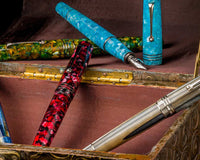In the fountain pen community, the question of which is the better of two nibs (steel and gold) is often hotly debated. Some fountain pen lovers will attest to the superiority of a gold nib, while other users will insist that a steel nib is just as good due to various factors. At the end of the day, is a precious gold nib really better than a plain steel one? Here, we’ll explore both and discuss the pros and cons of each so you can decide for yourself.
The Difference Between Gold and Steel Nibs
There are distinct differences between gold and steel nibs.
Gold nibs have long been associated with luxury and performance. The precious metal's malleability allows for intricate shaping and greater flexibility than steel. This flexibility translates to a smoother writing experience, with the nib conforming to the paper's surface. Additionally, gold nibs are less prone to corrosion, ensuring a longer lifespan.
However, the allure of gold comes with a price tag. High-quality gold nibs are significantly more expensive than their steel counterparts. While they offer a refined writing experience, it's essential to consider if the added cost justifies the benefits for your specific needs.
Then again, we shouldn’t underestimate the capabilities of a well-crafted steel nib. Modern metallurgy has produced steel alloys that are incredibly durable, resistant to corrosion, and offer a surprising level of flexibility. Many contemporary steel nibs deliver a writing experience that rivals their gold counterparts at a fraction of the cost.
Steel nibs are also more resistant to everyday damage, making them a practical choice for daily use or for those who tend to be a bit rough on their pens.
The Verdict: It Depends
Ultimately, the choice between a gold or steel nib comes down to personal preference and budget. If you prioritize a luxurious writing experience and are willing to invest in a high-quality pen, a gold nib might be the perfect choice. However, if you're looking for a reliable, affordable pen, a steel nib is an excellent option.
It's also worth noting that the quality of the nib, regardless of the material, plays a crucial role in writing performance. A well-crafted steel nib can outperform a poorly made gold nib and vice versa.
Key Factors to Consider
A few factors are worth considering when choosing between a gold-nibbed and a steel-nibbed fountain pen.
Budget
Due to the cost of gold and the craftsmanship involved, gold nibs are typically more expensive. This is ideal for those who value luxury and are willing to invest in a higher-end writing experience. Steel nibs are a more affordable option, making them a popular choice for beginners or those on a budget. They offer good performance without the premium price tag.
Writing Style
Gold nibs are often softer and more flexible, allowing for expressive writing with varying line widths. Suitable for those who enjoy calligraphy, script, or varying their writing style. Even gold nibs without flex are said to be springier and bouncier when writing.
While steel nibs can be manufactured to flex, they are generally made to be less flexible and provide a more consistent line width compared to gold nibs. This makes them ideal for everyday writing, note-taking, or those who prefer a more controlled writing experience.
Durability
Caring for gold fountain pen nibs will preserve their quality and durability, even if they are softer than steel nibs. High-quality gold nibs are built to last for many years. Steel nibs hold up quite well, too, as they are resistant to damage and bending. This makes them a good choice for those who are rough on their pens or travel frequently.
Personal Preference
The most important factor is personal preference. Experimenting with both types of nibs is essential to determine which feels best for you. Consider factors like nib size, line width, and overall writing experience.
Additional Considerations
Here are some additional considerations when selecting the better nib for your needs and preferences.
• Nib Grinds: The shape of the nib tip (fine, medium, broad, stub, architect, oblique, etc.) affects line width and writing experience.
• Flexibility: While gold nibs are often associated with flexibility, flexible steel nibs are also available.
• Nib Smoothness: Both gold and steel nibs can be smooth, but the level of smoothness can vary depending on the manufacturer and nib quality.
• Tipping Material: Iridium is most commonly used for both gold and steel nibs. It's a hard metal that provides durability and smooth ink flow. Some manufacturers experiment with different tipping materials, such as ruthenium or osmium, which can affect the nib's performance and lifespan.
The Bottom Line
Remember, the joy of fountain pen writing lies in the experience. Whether you choose gold or steel, the most important thing is to find a pen that brings you joy. We recommend attending local pen meets or paying a visit to the nearest fountain pen store to give each nib a try.
Which type of nib do you prefer?
Written by EndlessPens Blogger Ramona Kabigting











